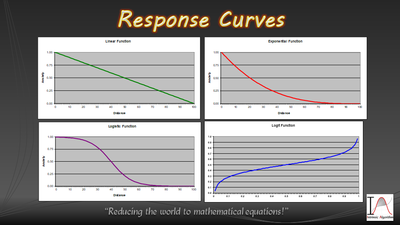Difference between revisions of "Response Curve"
From AI Product Manuals
Jump to navigationJump to search (Initial Entries) |
(Added image) |
||
| Line 1: | Line 1: | ||
== Concept == | |||
[[File:Response Curves.png|400px|thumb|right|Different types of response curves]] | |||
A Response Curve is a mathematical formula that converts an input value into an output value. It's comprised of a curve type and 4 variables. | A Response Curve is a mathematical formula that converts an input value into an output value. It's comprised of a curve type and 4 variables. | ||
Revision as of 19:07, 29 September 2021
Concept
A Response Curve is a mathematical formula that converts an input value into an output value. It's comprised of a curve type and 4 variables.
Components
Curve Types
The curve types are:
- Linear
- Polynomial
- Logistic
- Logit
- Normal (for a normal distribution)
- Sine
Variables
The 4 variables are, m, k, b, and c change their meanings slightly depending on the curve type.
For Linear and Polynomial types, they represent what we are used to seeing in the y = mx + b formula:
- m = slope (positive numbers for up, negative for down)
- k = exponent (1 = linear)
- b = y-intercept
- c = x-intercept
For Logistic curves, they are:
- m = slope of line in middle
- k = Vertical size and direction of curve (positive numbers for up, negative for down)
- b = moves line vertically from its starting point
- c = moves line horizontally from its starting point
For Normal curves, they are:
- m = width of the "bump" of the curve. Roughly equivalent to changing the standard deviation.
- k = height of the "bump"
- b = moves line vertically from its starting point
- c = moves line horizontally from its starting point
Code
The data is held in the very simple ResponseCurve class but the calculations are performed in the Consideration class in Consideration::GetConsiderationValue.
